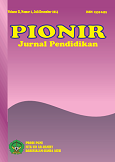THE UTILIZATION OF MICROSOFT SWAY IN PANCASILA EDUCATION LEARNING
DOI:
https://doi.org/10.22373/pjp.v13i1.21899Abstract
In the current educational landscape, Pancasila Education must integrate the principles of 21st-century learning, which emphasize the importance of technology utilization in education. The integration of media enhances the learning process, making it more accessible, engaging, effective, and efficient. This study seeks to explore how Microsoft Sway media is utilized in Pancasila Education classes at Kejambon 2 Public Elementary School. Utilizing a qualitative descriptive research method, the study investigates the impact and effectiveness of Microsoft Sway in enhancing Pancasila Education learning experiences. The research findings reveal that Microsoft Sway aligns well with the principles of 21st-century learning. It fosters increased student engagement and enthusiasm, shifting the focus of learning activities towards student-centered approaches. This integration not only modernizes the teaching-learning process but also nurtures critical thinking and active participation among students, thus enriching their understanding and appreciation of Pancasila values and principles.
Keywords: Microsoft Sway, Pancasila Education, 21st-century learningReferences
Agustin, M., Ibrahim, M., Kasiyun, S., & Ghufron, S. 2021. “Keefektifan Penggunaan Microsoft Office Sway dalam Memengaruhi Motivasi Belajar Siswa di Sekolah Dasar”. Jurnal Basicedu, 5(5).
Audia, C., dkk. 2021. “Development of Smart Card Media for Elementary Students”. Journal of Physics: Conference Series, 1783(1). https://doi.org/10.1088/1742-6596/1783/1/012114
Ghufron, Ghufron. 2018. "Revolusi Industri 4.0: Tantangan, Peluang, Dan Solusi Bagi Dunia Pendidikan." In Seminar Nasional Dan Diskusi Panel Multidisiplin Hasil Penelitian dan Pengabdian Kepada Masyarakat 2018. Vol. 1.
Hamzah, & Rahman, A. 2016. “Pengembangan Media Pembelajaran IPS Berbasis Website untuk Siswa Kelas VII Madrasah Tsanawiyah Negeri”. Jurnal Teknologi Pendidikan, 18(3), 169-185. https://doi.org/10.21009/jtp.v18i3.5372
Indonesia. Keputusan Kepala Badan Standar, Kurikulum, Dan Asesmen Pendidikan Kementerian Pendidikan, Kebudayaan, Riset, Dan Teknologi Nomor 008/H/Kr/2022 Tentang Capaian Pembelajaran Pada Pendidikan Anak Usia Dini, Jenjang Pendidikan Dasar, Dan Jenjang Pendidikan Menengah Pada Kurikulum Merdeka. Sekretariat Negara. Jakarta.
Kustandi, C., & Darmawan, D. 2020. Pengembangan Media Pembelajaran Konsep & Aplikasi Pengembangan Media Pembelajaran Bagi Pendidik di Sekolah dan Masyarakat. Kencana.
Prayogi, R. D. 2020. Kecakapan abad 21: Kompetensi digital pendidik masa depan. Manajemen Pendidikan, 14(2).
Sukmadinata dan Nana Syaodih. 2013. Metode Penelitian Pendidikan. Bandung: Rosda Karya.
Sulastri, S., Fitria, H., & Martha, A. 2020. “Kompetensi profesional guru dalam meningkatkan mutu pendidikan”. Journal of Education Research, 1(3).
Suryandaru, N. A., & Setyaningtyas, E. W. 2021. “Pengembangan media pembelajaran berbasis website pada muatan pembelajaran matematika kelas IV”. Jurnal Basicedu, 5(6).
Usodo, Budi dan Deshinta. 2016. “Penerapan Beberapa Aplikasi Dari Microsoft : Office Mix, Onenote, Sway Pada Pembelajaran Matematika.” Jurnal. Fkip. UNS 4(November).
Downloads
Published
Issue
Section
License
- Authors retain copyright and grant the journal right of first publication with the work simultaneously licensed under a Creative Commons Attribution License that allows others to share the work with an acknowledgment of the work's authorship and initial publication in this journal.
- Authors are able to enter into separate, additional contractual arrangements for the non-exclusive distribution of the journal's published version of the work (e.g., post it to an institutional repository or publish it in a book), with an acknowledgment of its initial publication in this journal.
- Authors are permitted and encouraged to post their work online (e.g., in institutional repositories or on their website) prior to and during the submission process, as it can lead to productive exchanges, as well as earlier and greater citation of published work (See The Effect of Open Access).

